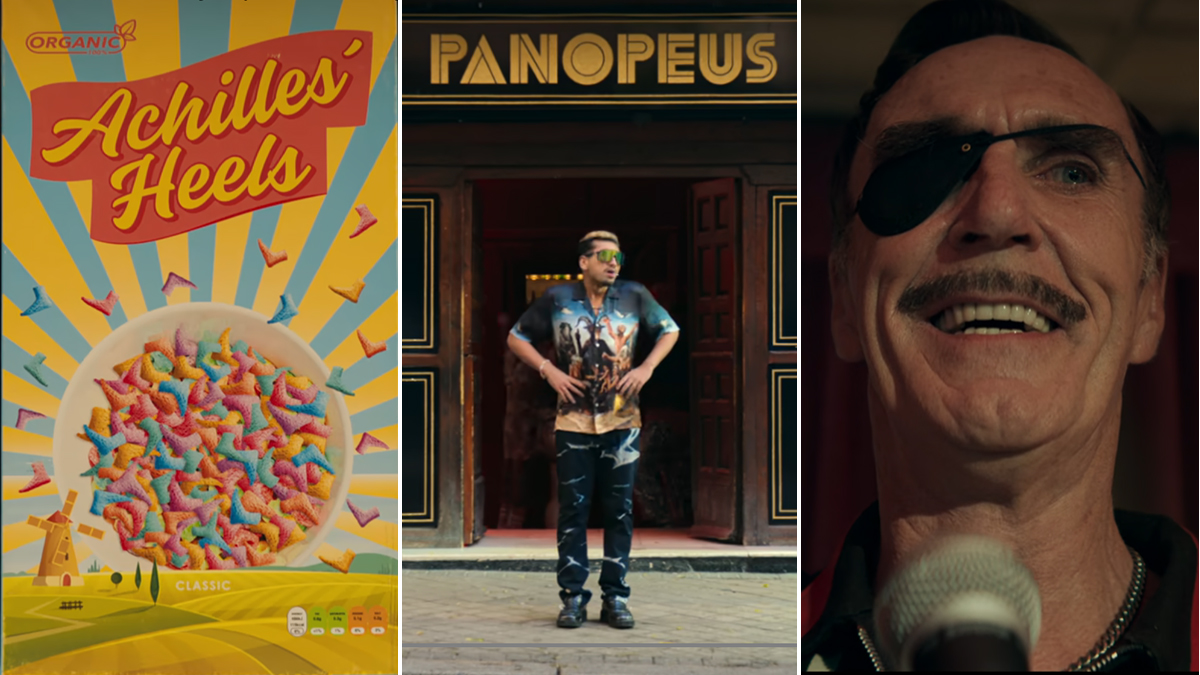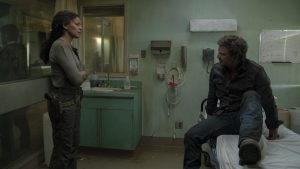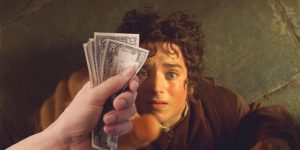
Warning: contains some plot details for KAOS
There’s so much to enjoy about Netflix’s KAOS‘ stories and characters that it’d be easy to miss the effort put in to its production design. This show’s scripts aren’t the only things studded with details from Greek myth. From the costumes to the set dressing, from its world’s brand names to symbols and in-jokes, it’s full of nerdy elements to tease out. Not since Baz Luhrmann‘s Romeo + Juliet gave its guns ‘Sword’ and ‘Dagger’ brand names have the ancient and the modern been combined so satisfyingly on screen.
Here are just a few of the Easter Eggs and background details that Greek myth geeks might have spotted. Add your own spots in the comments below.
1. Zeus’ thunderbolt symbol is everywhere in Heraklion on Olympia Day, from banners on the street, to gold necklaces worn by Calli and other characters, to the plastic toy versions available to buy alongside little Poseidon tridents in the supermarket. It’s also seen in neon in the bar where Caeneus worked, and in Olympus decorating the palace and Zeus’ natty lounge suit.
2. Orpheus and Riddy live at “Villa Thrace”, which is a nod to the mythical bard Orpheus’ home town.
3. Orpheus has a lyre tattooed on the inside of his right arm, signifying his mythical instrument, which also appears as the name of one of his albums on a poster. He also has the Titan Atlas shouldering the world on his left arm, and various other Greek myths in tattoo form.
4. At the supermarket, Riddy buys a box of Spartan Crunch cereal, “made with 100% Olympus honey”. The Spartans were ancient Greek warriors and that honey was produced by Hera’s bees, who in KAOS were once the human mothers of Zeus’ various children.
5. Other supermarket cereals available are: Achilles Heels (in reference to the Greek warrior who slayed the Trojan Prince Hector, and who, as an infant, was made almost unkillable when his dipped him into the River Styx, leaving only the heel by which she was holding him vulnerable to wounds). There’s also Gaea’s Granola, named for the personification of the Earth; and Méli (the Greek word for honey) Morn cereal, with a picture of a Mélissa (or in English, bee) on the box.
6. Riddy also buys a pomegranate. In the myth of Persephone and Hades, Persephone is tricked into having to spend six months of every year underground with Hades after eating nine pomegranate seeds while being held prisoner in the underworld.
7. Cassandra, played here by Billie Piper, is a Trojan prophetess (hence the vertical nose tattoo, which identifies Trojan refugees in this post-Siege of Troy setting) who was gifted the power of prophesy by the god Apollo, but when she rejected him, he cursed her never to be believed. She tells Riddy that she prophesied “the horse” and “the men hidden inside”, referring to the famous story of the Trojan Horse.
8. The peacocks you see wandering around Olympus are a sacred bird to the goddess Hera.
9. The club Dionysus emerges from is named Panopeus, which was an ancient Greek town mentioned by ancient Greek poet Homer as having “beautiful dancing floors” where the god Dionysus was celebrated with dance and orgies.
10. Riddy getting hit by a truck branded “Serpent Solutions” (and wearing a snake-shaped gold ring) is a neat reference to the fact that the mythical character of Eurydice, whom Orpheus pursues into the underworld, dies after being bitten by a snake.
11. Hera, and the security guard at her temple, both read the “Echo” newspaper in reference to the myth of Echo and Narcissus from Ovid’s The Metamorphoses, in which a beautiful youth rejects a nymph and dies after falling in love with his own reflection.
12. There are various other newspapers and magazines available on Krete, including the Mercury (something of a branding conflict as Mercury was a Roman god whose Greek equivalent was Hermes); Moros, named for the Greek god of doom; Hector’s Herald, named for the Trojan prince slain by Achilles; Chaossa, named for the Greek state of chaos from which the series takes its title; Angel and Muse; and best of all, what looks like a running mag named “Clops” – perfect for centaurs, satyrs and the like.
13. The blossoming tree in the Olympus breakfast room could well be the apple tree that produces golden apples, which was gifted to Zeus and Hera by Gaea as a wedding present.
14. Riddy drives past a poster advertising male strip group “The Centaurs”, a half-man-half-horse take on “The Chippendales”.
15. Orpheus’ manager is named Calli, which is short for Calliope, the muse of poetry who taught Orpheus verses to sing.
16. When Orpheus buys cigarettes from the kiosk, he asks for “20 Boreas”. Boreas is the mythic personification of the North Wind, and according to some stories, Orpheus was in love with Boreas’ son.
17. This could be nothing, but the local bank appears to be called Onochoe Bank, which is very similar to the Greek word ‘oinochoe’ used to describe a clay jug used to contain wine.
18. In the bar where Caeneus worked before he was killed, there’s a neon sign advertising “Meanad Triple Sec”, a brand name similar to “Maenad”, a word to describe a female worshipper of Dionysus.
19. The ‘port’ of Asphodel is named for the mythic Asphodel Meadows, which were one of the three main sections of the underworld, along with Elysium and Tartarus, Greek myth’s equivalent to heaven and hell.
20. The three-headed “Cerberus” dogs patrolling the border to the underworld are named for the mythical three-headed Cerberus dog who guards the entrance to Hades in myth, and whom Orpheus lulled to sleep with a tune from his lyre. The name of Caeneus’ dog Fotis translates from Greek as “light”.
21. The name of the bar where the Fates hold their mortals-to-the-underworld contests is “The Cave” in reference to the cave through which the mythic Orpheus travelled to Hades.
22. The eyepatch-wearing security guard at The Cave is called Poly – named after Polyphemus, the most famous of the race of one-eyed giants known as the Cyclops.
23. The Three Fates: Atropos, Lachesis “Lachey”, and Clotho have the same names of their mythical counterparts who span – and cut – the threads of human life and ensured that humans carried out their prophesied destinies.
24. The gas station is named Tyndareus, after the famous King of Sparta and husband of Leda, whom Zeus raped while disguised as a swan. Tyndareus was the father of Helen of Troy, wife of Spartan king Menelaus.
25. The Three Furies Tisi, Alecto and Meg are named for their mythical counterparts (also known as Erinyes) Tisiphone, Alecto and Megaera, all of whom appear as characters in Virgil’s Latin poem The Aeneid.
26. According to the name The Furies cross off their list, the man who shot himself in the gas station toilet is Tereus. In Greek myth, Tereus was the King of Thrace who raped his sister-in-law and cut out her tongue to prevent her from telling anybody but she told her sister via embroidery.
27. Ari’s twin brother Glaucus was not related to her or to the story of the Minotaur in Greek myth, but was a sea god who became immortal after eating a magical herb. After the mythical Ariadne was abandoned by Theseus in some stories, she and Glaucus had an affair, and Glaucus was eventually defeated by Dionysus – Ariadne’s immortal love interest.
28. Troytown is the area on Krete reserved for refugees of the Trojan war after the destructive Siege of Troy. In the series, that’s where Hecuba, Andromache and Theseus’ boyfriend Nax live.
29. Theseus’ baseball team are The Satyrs, creatures from Greek myth with the head and body of a man and the legs of a goat.
30. Charon is also the mythical boatman who carries dead souls over the River Styx into Hades in Greek myth (though in the stories, his boat didn’t have an outboard motor).
31. Hippolyta the Amazon (race of mythical Greek women warriors) who dies in The Munis fight to the death has only one breast and a scar on her chest because the Amazons were said to remove their right breast to enable spear-throwing.
32. The Scylla that Charon names while crossing the River Styx is a legendary man-eating monster mentioned in Homer’s Odyssey, with a mythical counterpart named Charybdis.
33. There’s a little gag when Hera tells Persephone to “bring a sandwich” because she won’t be catering the family meeting in the final episode. It’s a reference to the mythic Persephone becoming trapped in the underworld for six months of every year after eating nine pomegranate seeds while kept there. KAOS’ Persephone doesn’t even eat pomegranate, she says – she’s allergic. Note that she makes her leftover sandwiches into a restaurant leftovers-style tin foil swan, perhaps referring to Zeus’ rape of Leda while in swan form.
KAOS is out now on Netflix.
The post KAOS Easter Eggs: Spotting the Nerdy Greek Myth Details in Netflix’s Fantasy Series appeared first on Den of Geek.






